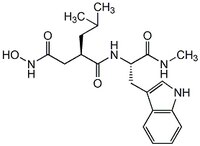364205 Sigma-AldrichGM 6001 - CAS 142880-36-2 - Calbiochem
GM 6001, CAS 142880-36-2, is a potent, cell-permeable, broad-spectrum inhibitor of MMPs (Ki = 400 pM for MMP-1; 500 pM for MMP-2; 27 nM for MMP-3; 100 pM for MMP-8; and 200 pM for MMP-9).
More>> GM 6001, CAS 142880-36-2, is a potent, cell-permeable, broad-spectrum inhibitor of MMPs (Ki = 400 pM for MMP-1; 500 pM for MMP-2; 27 nM for MMP-3; 100 pM for MMP-8; and 200 pM for MMP-9). Less<<Synonyms: Galardin, N-[(2R)-2-(Hydroxamidocarbonylmethyl)-4-methylpentanoyl]-L-tryptophan Methylamide
Recommended Products
Overview
| Replacement Information |
|---|
Key Spec Table
| CAS # | Empirical Formula |
|---|---|
| 142880-36-2 | C₂₀H₂₈N₄O₄ |
Pricing & Availability
| Catalogue Number | Availability | Packaging | Qty/Pack | Price | Quantity | |
|---|---|---|---|---|---|---|
| 364205-1MG |
|
Plastic ampoule | 1 mg |
|
— | |
| 364205-5MG |
|
Plastic ampoule | 5 mg |
|
— |
| Description | |
|---|---|
| Overview | A potent, cell-permeable, broad-spectrum hydroxamic acid inhibitor of matrix metalloproteinases (MMPs); (Ki = 400 pM for MMP-1; Ki = 500 pM for MMP-2; Ki = 27 nM for MMP-3; Ki = 100 pM for MMP-8; and Ki = 200 pM for MMP-9). Prevents the release of TNF-α in vivo and in vitro and abrogates endotoxin-induced lethality in mice. A 10 mM (1 mg/257 µl) solution of GM6001 (Cat. No. 364206) in DMSO is also available. |
| Catalogue Number | 364205 |
| Brand Family | Calbiochem® |
| Synonyms | Galardin, N-[(2R)-2-(Hydroxamidocarbonylmethyl)-4-methylpentanoyl]-L-tryptophan Methylamide |
| Product Information | |
|---|---|
| CAS number | 142880-36-2 |
| ATP Competitive | N |
| Form | Off-white solid |
| Hill Formula | C₂₀H₂₈N₄O₄ |
| Chemical formula | C₂₀H₂₈N₄O₄ |
| Reversible | N |
| Structure formula Image | |
| Quality Level | MQ100 |
| Biological Information | |
|---|---|
| Primary Target | MMP-1 |
| Primary Target K<sub>i</sub> | 400 pM for MMP-1; 500 pM for MMP-2; 27 nM for MMP-3; 100 pM for MMP-8; 200 pM for MMP-9 |
| Purity | ≥95% by HPLC |
| Physicochemical Information | |
|---|---|
| Cell permeable | Y |
| Dimensions |
|---|
| Materials Information |
|---|
| Toxicological Information |
|---|
| Safety Information according to GHS |
|---|
| Safety Information |
|---|
| Product Usage Statements |
|---|
| Packaging Information |
|---|
| Transport Information |
|---|
| Supplemental Information |
|---|
| Specifications |
|---|
| Global Trade Item Number | |
|---|---|
| Catalogue Number | GTIN |
| 364205-1MG | 04055977213744 |
| 364205-5MG | 04055977213799 |
Documentation
GM 6001 - CAS 142880-36-2 - Calbiochem MSDS
| Title |
|---|
GM 6001 - CAS 142880-36-2 - Calbiochem Certificates of Analysis
| Title | Lot Number |
|---|---|
| 364205 |
References
| Reference overview |
|---|
| Solorzano, C.C., et al. 1997. Shock 7, 427. Galardy, R.E., et al. 1994. Ann. NY Acad. Sci. 732, 315. Galardy, R.E., et al. 1994. Cancer Res. 54, 4715. Galardy, R.E. 1993. Drugs Future 18, 1109. Grobelny, D., et al. 1992. Biochemistry 31, 7152. |
Citations
| Title | |
|---|---|
|
|
| Data Sheet | ||||||||||||||||||||||||||||||
|---|---|---|---|---|---|---|---|---|---|---|---|---|---|---|---|---|---|---|---|---|---|---|---|---|---|---|---|---|---|---|
|
Note that this data sheet is not lot-specific and is representative of the current specifications for this product. Please consult the vial label and the certificate of analysis for information on specific lots. Also note that shipping conditions may differ from storage conditions.
|







